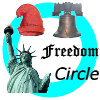Birthplace of
Henry Hazlitt, Henry Stuart Hazlitt, on 28 Nov
1894
Walter E. Williams, Walter Edward Williams, on 31 Mar
1936
Events of Interest
United States Declaration of Independence, adopted by the Second Continental Congress, on 4 Jul
1776
Web Pages
The man who financed the American Revolution, by
Jim Powell,
LibertyStory.net
Lengthy biographical essay of Robert Morris, a signer of the Declaration of Independence (and other founding documents) and financier of the Revolutionary War
Young Robert displayed an aptitude for business and was apprenticed with merchant Charles Willing. By 1754, he was a partner. The firm grew to be one of the largest merchant firms in Philadelphia, with its own fleet of ships which sailed to Europe and the West Indies ... By [1781], finances were a mess. The paper money was used as wallpaper. "In Philadelphia," Oberholtzer wrote, "men who wore the bills as cockades in their hats marched in a procession through the public streets accompanied by a dog which was covered with a coat of tar in which the despised pieces of paper were thickly set ..."
Articles
Benjamin Franklin: The Man Who Invented the American Dream, by
Jim Powell,
The Freeman, Apr 1997
Lengthy biographical essay, including a section on the posthumous publication and reaction to Franklin's
Autobiography
When Franklin saw that something needed doing, he did it. In Philadelphia, he helped launch the city's first police force, the first volunteer fire company, the first fire insurance firm, the first hospital, the first public library, and the academy that became the first institution of higher learning (the University of Pennsylvania) ... In 1758, when he was 52, he suggested establishing Philadelphia's first school for blacks ... During the next three decades, Franklin's Junto helped pioneer many of Philadelphia's institutions, starting with the city's first public library.
Related Topics:
John Adams,
American Revolutionary War,
United States Constitution,
United States Declaration of Independence,
Entrepreneurship,
France,
Benjamin Franklin,
Thomas Jefferson,
Massachusetts,
Thomas Paine,
Pennsylvania,
No quartering of Soldiers,
Taxation,
George Washington
Dictatorship of Gadflies, by
James Bovard,
Freedom Daily, Nov 1998
Discusses the efforts of the National Trust for Historic Preservation and similar groups to preserve much broader targets than historically meaningful buildings
Preservation advocates endlessly repeat that imposition of government controls over property owners practically guarantees an increase in property values ... A 1994 study in the Journal of Real Estate Finance and Economics concluded that local historic preservation controls in Philadelphia resulted in a 24 percent reduction in the price of small apartment buildings. The study, authored by two professors at the Temple School of Business and Management, concluded that "historic control (as practiced in Philadelphia) is confiscatory." Preservation bureaucrats control more than 15,000 buildings in Philadelphia.
Is This Really War?, by
Sheldon Richman, 16 Jun 2006
Discusses the Haditha killings and argues that U.S. troops in Iraq were acting more as a police force for the new Iraqi regime, which was incompatible with their military training
In 1985, Wilson Goode became the first U.S. mayor to bomb his own city. In an effort to rid a West Philadelphia neighborhood of a ragtag, violent, back-to-nature organization called Move, which had engaged in a shootout with police, Goode ordered explosives dropped on the Move house ... The whole block of row houses burned, 61 homes in all. Eleven people were killed, five of them children ... At least in Goode's case he could claim he was ... using the police to suppress a dangerous group that not only engaged in violence but also lived in an unsanitary way that affected its neighbors.
 The Third Amendment and the Issue of the Maintenance of Standing Armies: A Legal History
The Third Amendment and the Issue of the Maintenance of Standing Armies: A Legal History, by
William S. Fields,
David T. Hardy,
American Journal of Legal History, 1991
Examines the history of quartering of soldiers in private residences and the maintenance of standing armies, both in England and the United States revolutionary and constitutional convention periods
The quartering of soldiers became a significant problem for the colonies ... with the arrival of thousands of British regulars during the Seven Years War ... Colonel Henry Bouquet and his men met similar opposition in Philadelphia. The army's request for lodging languished for weeks in the Pennsylvania legislature. The few buildings, which the city provided for Bouquet’s men, were insufficient to house all of the soldiers. Over a hundred of the men were forced to sleep outside in the snow. Under those conditions many came down with small pox.
Related Topics:
Standing Army,
United States Bill of Rights,
Edward Coke,
Thirteen Colonies,
United States Declaration of Independence,
England,
Patrick Henry,
James Madison,
George Mason,
New York City,
Petition of Right,
No quartering of Soldiers
